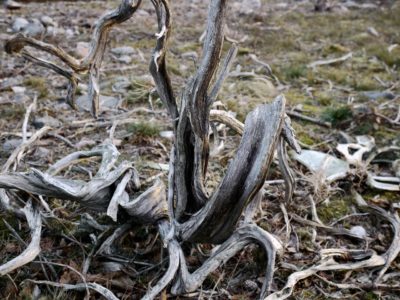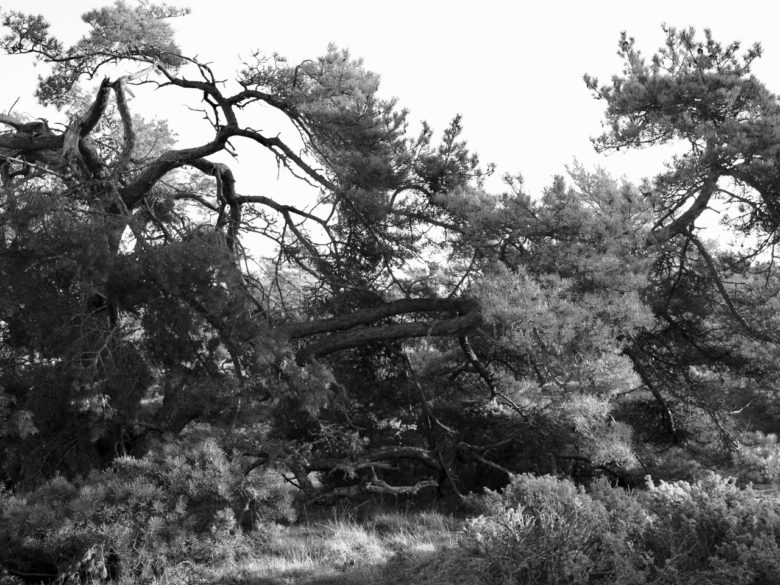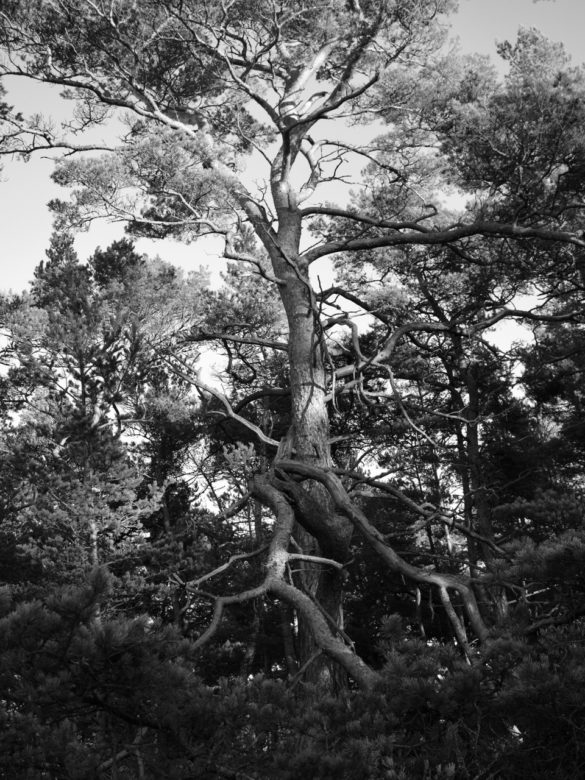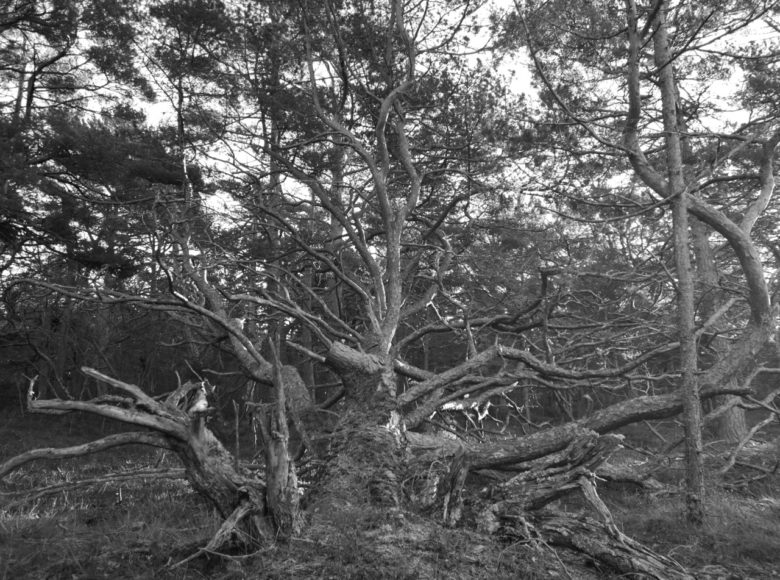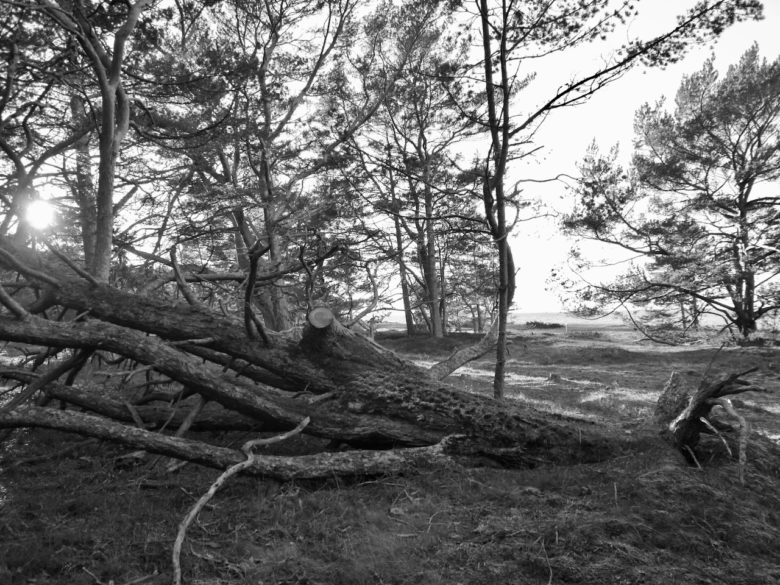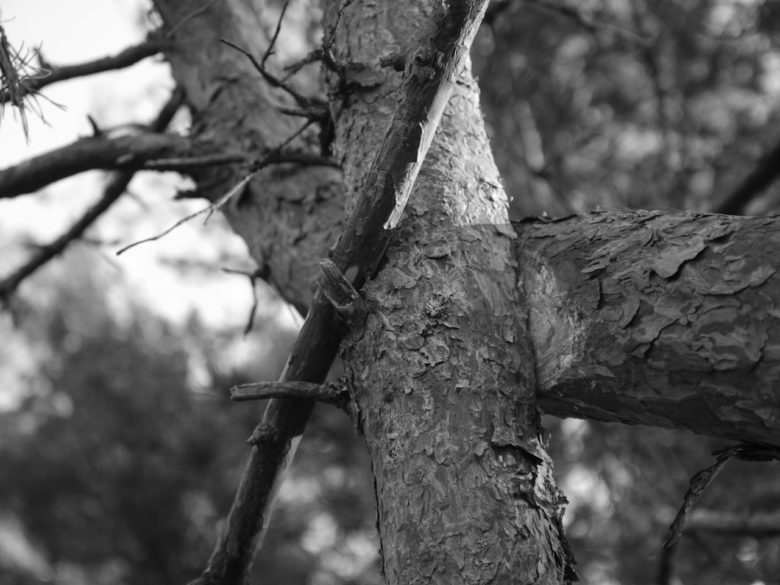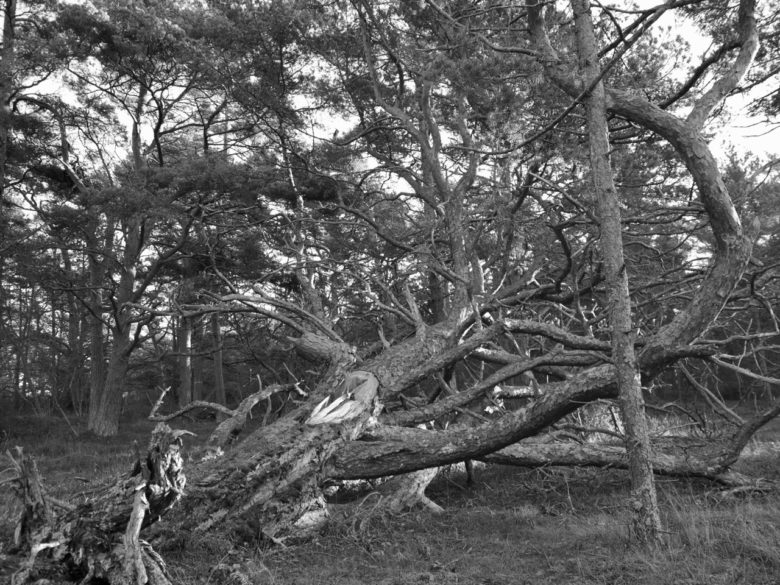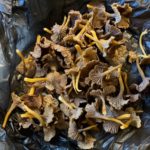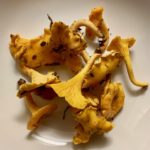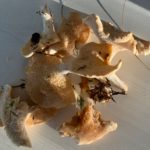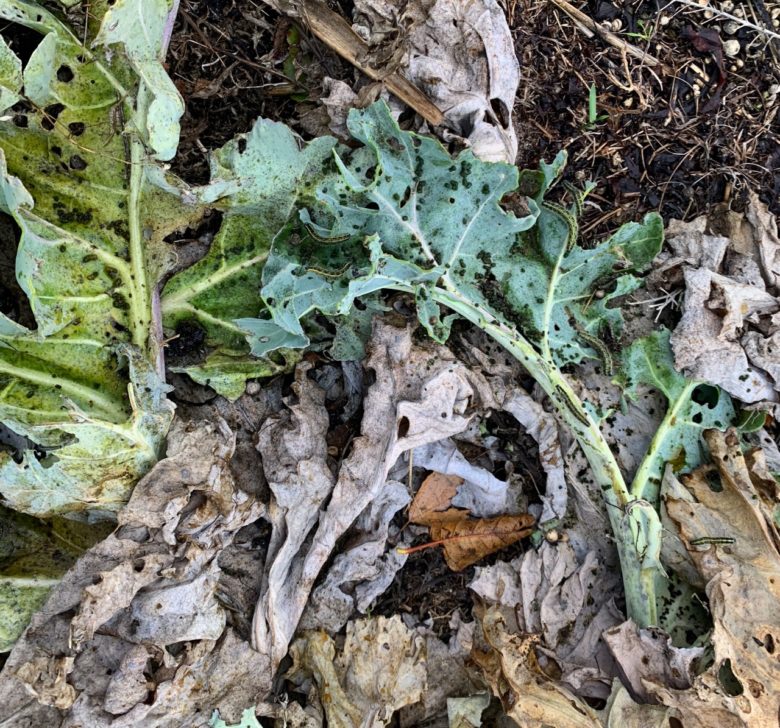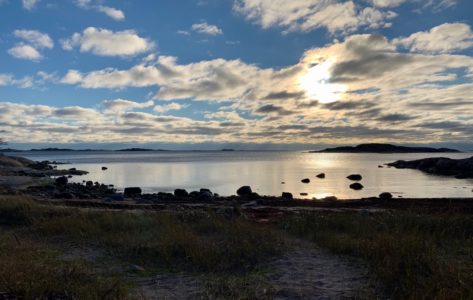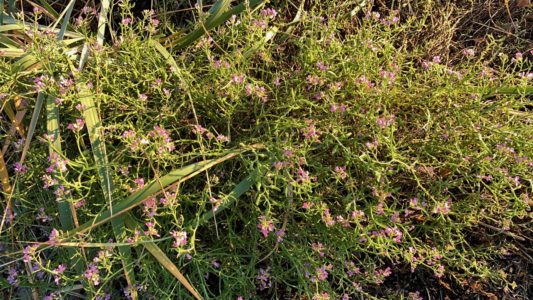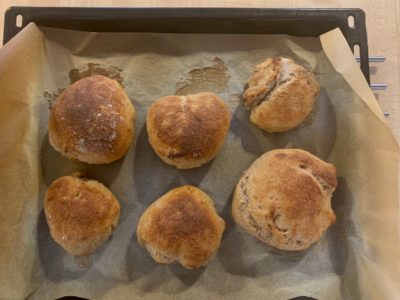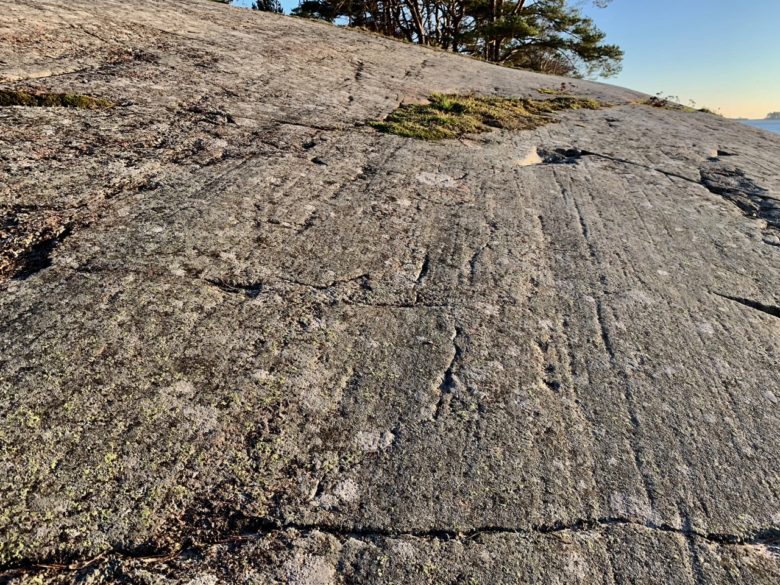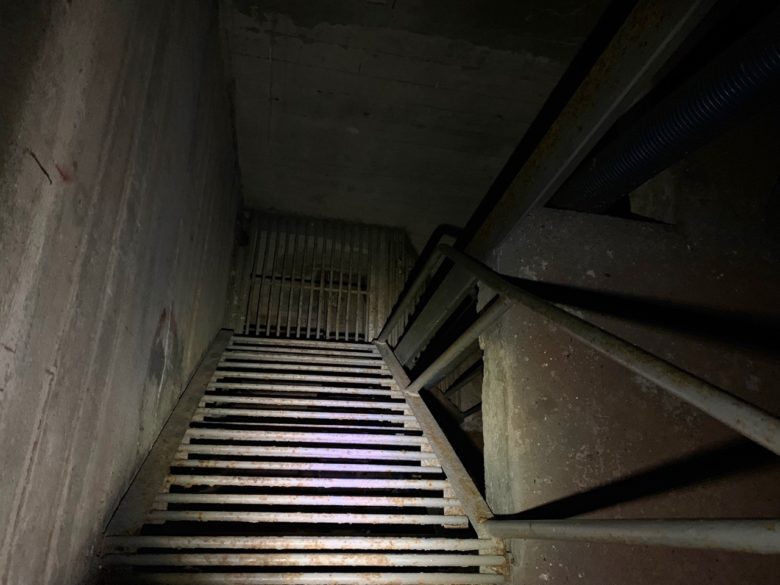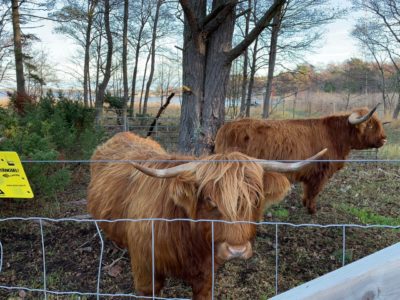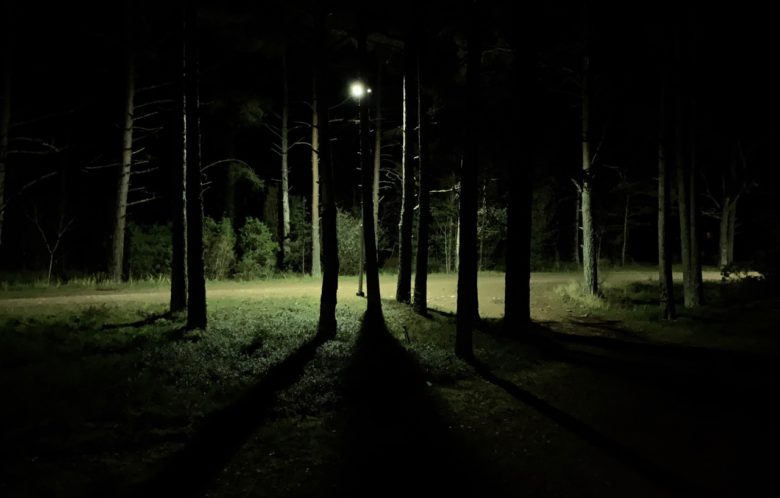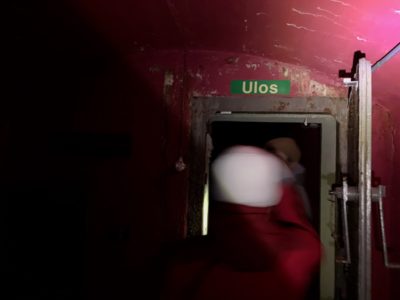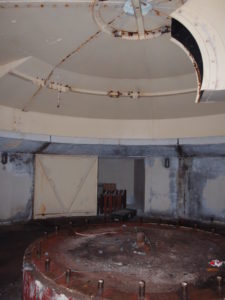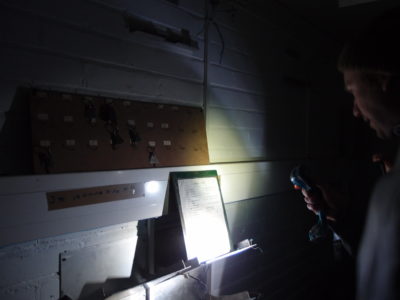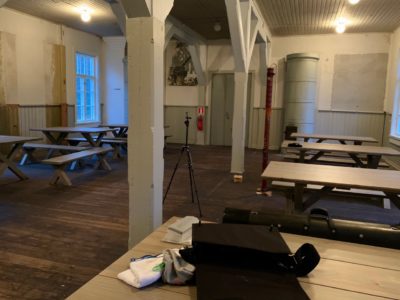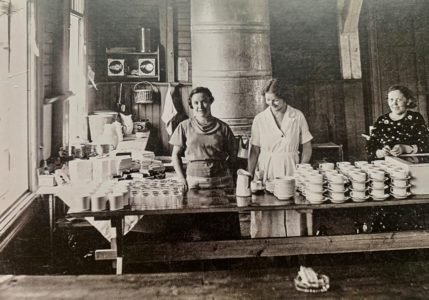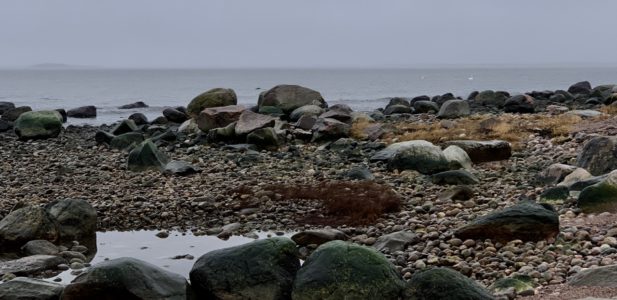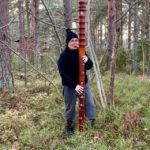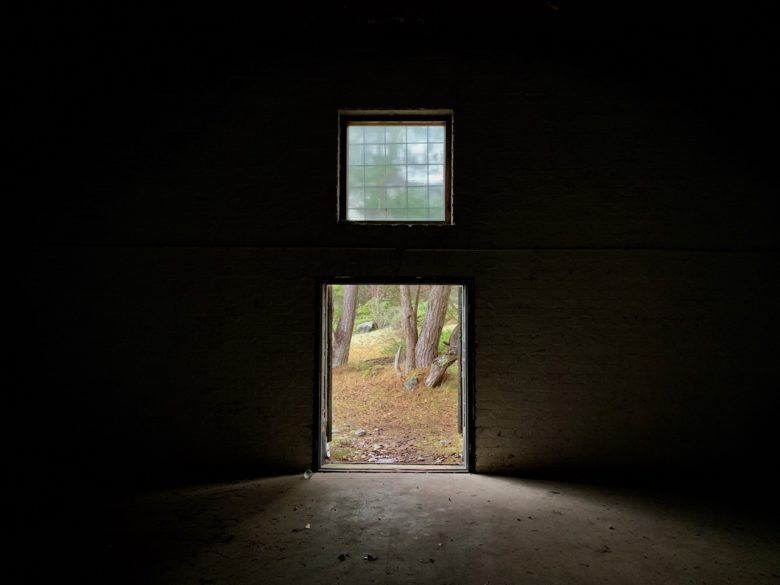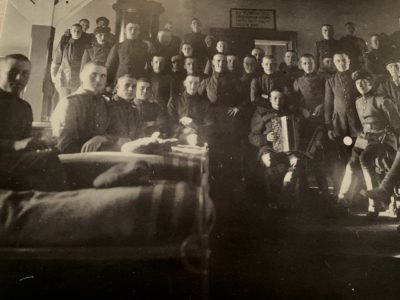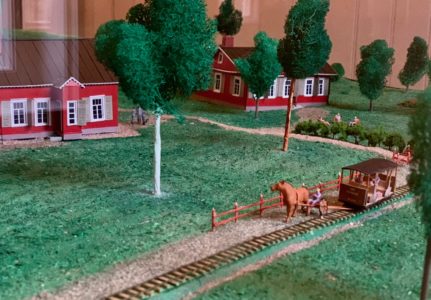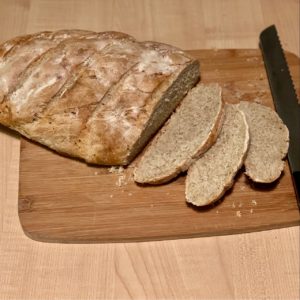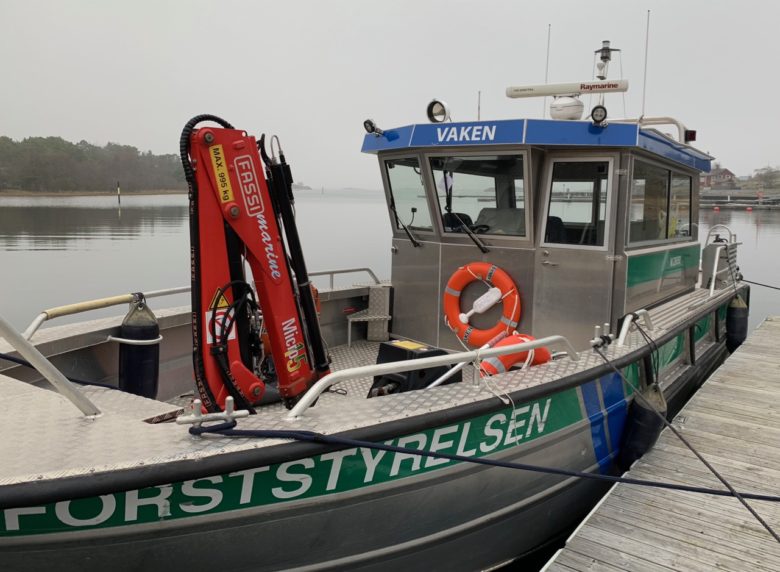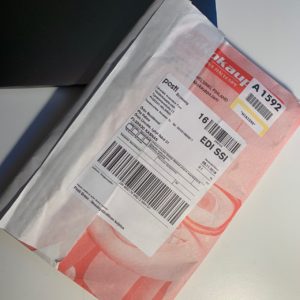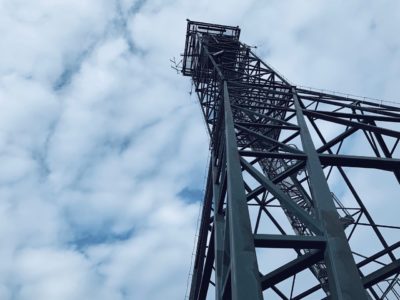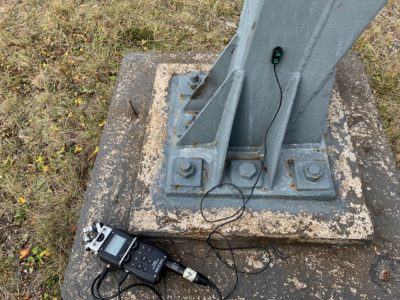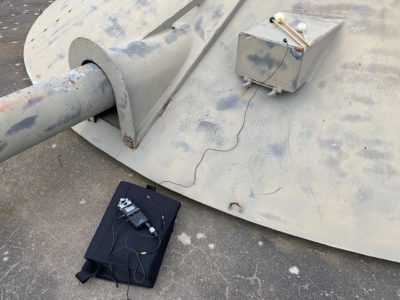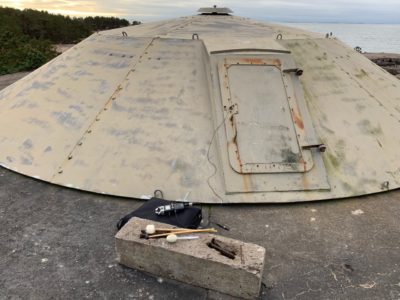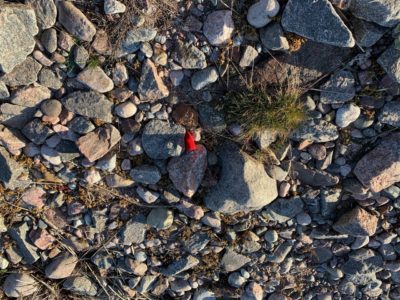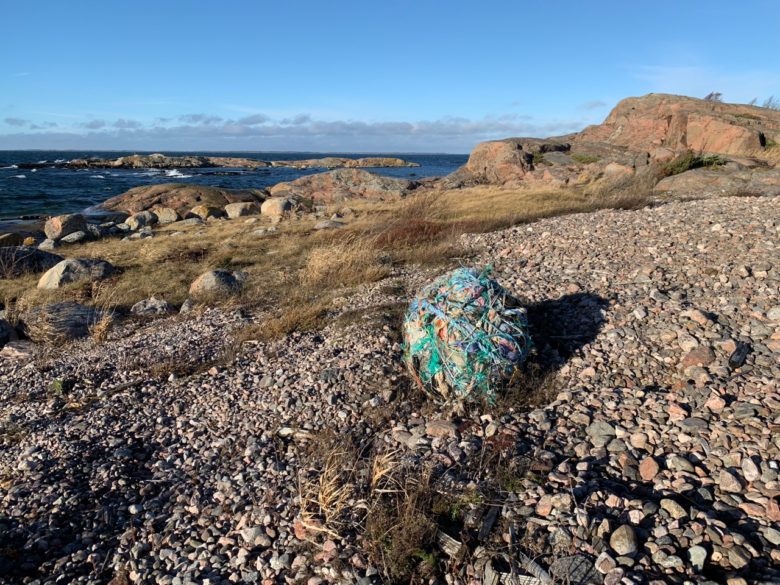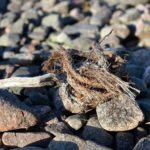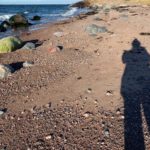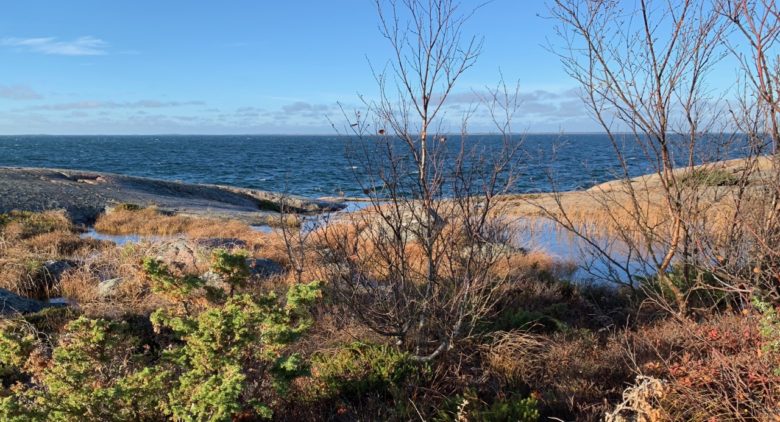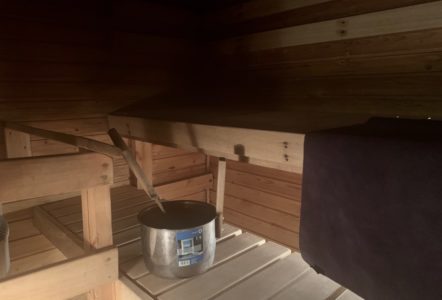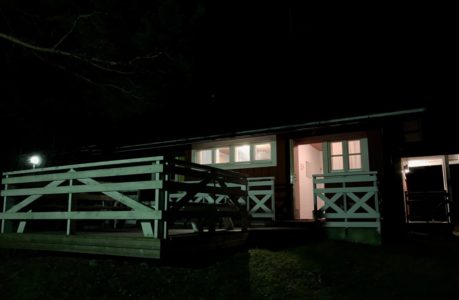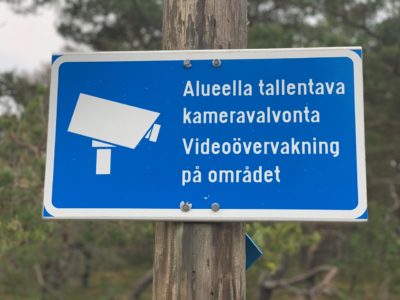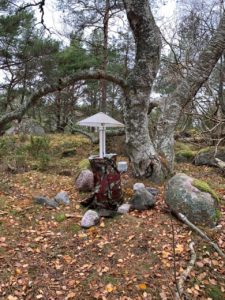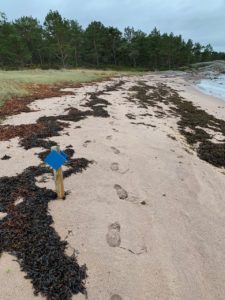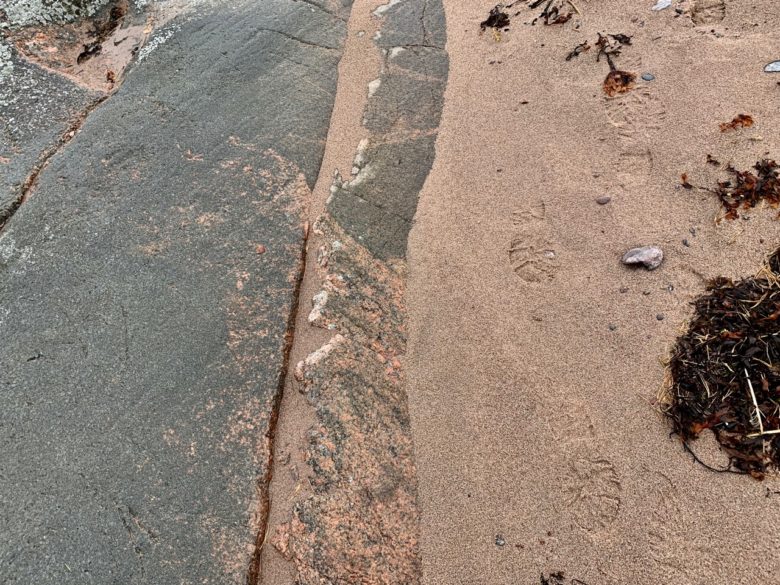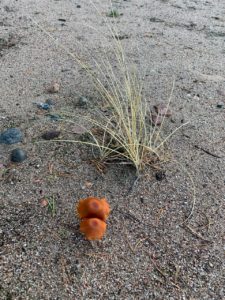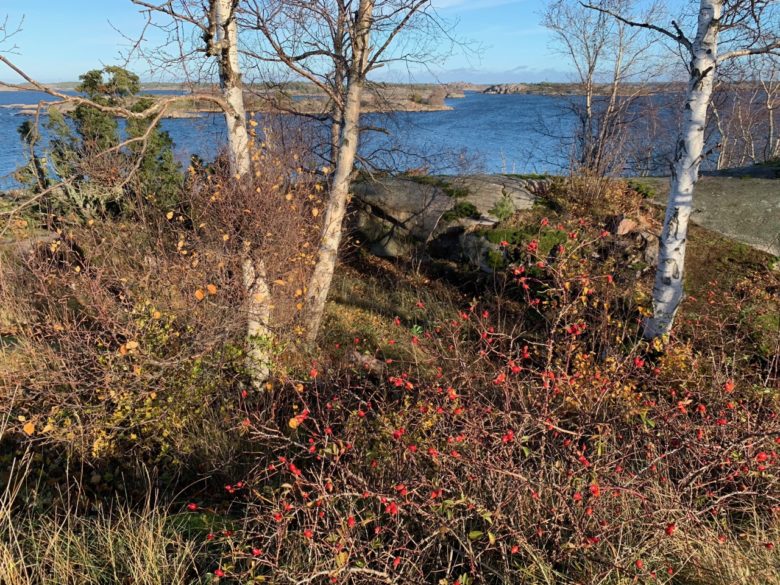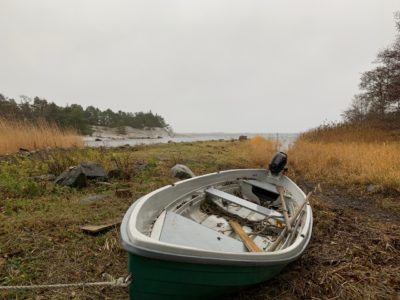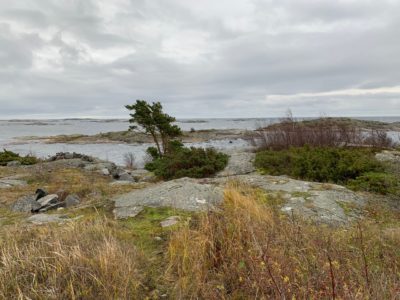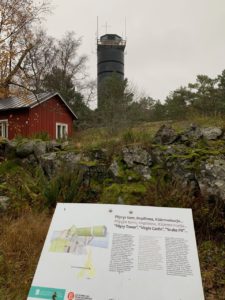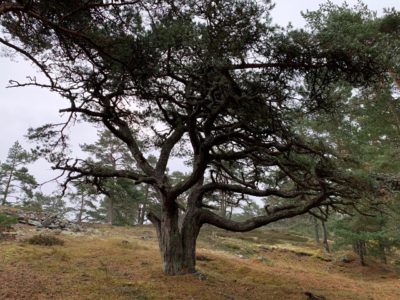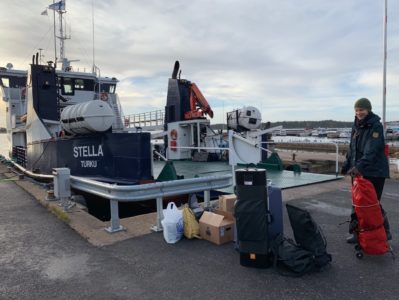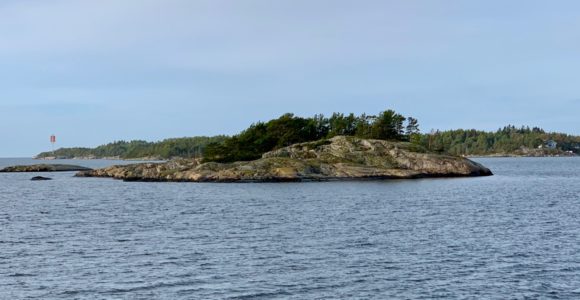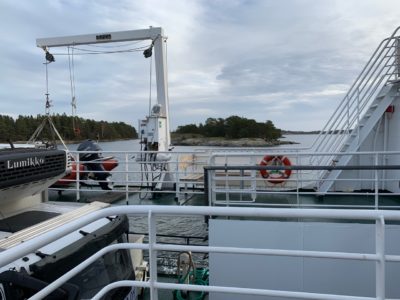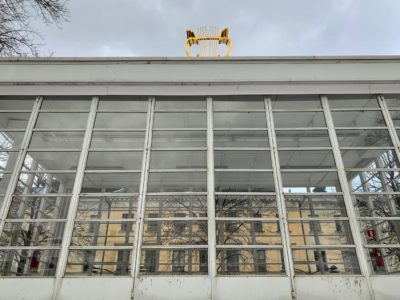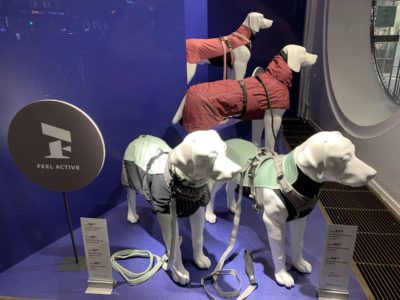This blog was written on the tiny island Örö in the Baltic Sea, between November 1-30, 2018 and was originally published in cooperation with the festival wienmodern 2018. The festival’s motto was “security”.
Örö Island
Latitude/longitude: 59°47′59″N22°19′59″E
Decimal coordinates: 59.8000 22.3333
Altitude: ca. 4 m.a.s.l. (approximate)
- ESCR #19
29-30/11 Farewell Örö
Winter has finally come to the archipelago. I took a last walk to the northern tip. This end of Örö is almost always windy and colder than the southern and eastern shores, although the distance is only few kilometers. The late afternoon light was dim with dreary clouds and a snowstorm approaching. At the same time, a dark grey Finnish warship had appeared in western direction. Military performances were being held right in front of the shore. Heavy gun fire erupted at irregular intervals. I could feel the strong detonations in my body; the loudest ones always blasted in quintuples. On the stony shore, I found a spot full of bleached and twisted juniper wood. In my imagination, the woods evoked the image of a baroque sculpture garden. In the midst of the wooden forms I spotted torn remnants of a seal carcass. Another layer of biological baroqueness. I recorded, took pictures, and filmed. A feast for the eyes, in low phenomena terrain.
On my way back I met a brown eagle. Eagles occur in boreal forests, as I have been told. With dusk falling in, I quietly moved along the shoreline. Shrubs and sparse trees were standing below, closer to the water. The huge bird flew off from one the juniper bushes nearby, appraoched me from behind and passed me just by my left shoulder, less than two meters away, quickly disappearing along the path and higher into the forest. It came so close that I felt like I could hold on to its back and take off. I clearly saw its feathery head and the muscular shoulders moving its strong wings. I have never seen a flying eagle from this perspective, let alone that close.
On my way back I met a brown eagle. Eagles occur in boreal forests, as I have been told. With dusk falling in, I quietly moved along the shoreline. Shrubs and sparse trees were standing below, closer to the water. The huge bird flew off from one the juniper bushes nearby, appraoched me from behind and passed me just by my left shoulder, less than two meters away, quickly disappearing along the path and higher into the forest. It came so close that I felt like I could hold on to its back and take off. I clearly saw its feathery head and the muscular shoulders moving its strong wings. I have never seen a flying eagle from this perspective, let alone that close.I have now returned to Helsinki. The journey took seven hours, including two hours that Marja and I had to spend waiting at the Örö harbour, while the ferry got ready for departure. At this time of the year, there are no fixed schedules for ferry rides; everything must be negotiated according to various professional needs. Heavy machinery was unloaded and brought to various places at the island. The machines will be used for building purposes; several of the century-old wooden houses are being renovated. At the same time, all power supplies on the island were shut down. Our residency was cold, without light and water. The truck then went back to the mainland with the ferry, too.
The boat was old and weathered. I immediately fall in love with the ancient workbench on deck. The experienced captain steered in his socks. The strictly observed Finnish rule to take off one’s shoes whenever entering a house was to be followed in his cabin, too. With a carpet on the floor and an orchid in the window, this cabin was a living room, indeed. Outside the weather was stormy, waves quite high. A hitchhike towards Helsinki greatly helped Marja and me on our way home. A construction engineer whom we met in the ferry offered a ride to us, including our bulky luggage. From Kasnäs, at this time of the year, no bus connections to Helsinki are available; we were truly lucky.
I’m back to urban life, to people, cars, roads, city noises, shops, flashing lights all over. At the moment, it is nearly impossible to find words. I’m in a state of in-between. I carry the imprint of an island on my heart. - ESCR #18
28/11 Resilience and Change
During my strolls over the island I have noticed a number of uniquely formed trees. The boreal forest in Örö is relatively young. When Örö was first used for military purposes, the woods were felled. Aerial views from the beginning of the 20th century show a barren landscape with multiple military edifices such as harbours, dockyard, barracks, heavy guns, artillery positions, industrial buildings, stables, the road and even a short railroad track. Over the last decades, the forest and shrubs were allowed to regrow; woodland quickly spread out. However, conditions in the archipelago are rough; trees must cope with strong winds and poor soil.
Three peculiar trees, unique specimen, caught my attention. Their life stores have touched me, as an artist and human being. Studying their shape, I read about their lives and experiences, and how they reacted individually. I learn to know them as personalities, with their peculiar characters. Trees communicate their life stories through their form and growth – a mode of embodied plant story telling. I often stayed for a longer time in the company of one of them. Observing the tree in silence, it becomes close to me, almost like a friend, but certainly like an individual that I know very well. The trees featured here have all been deeply wounded in middle age, most likely by heavy winds. Every one of them demonstrates remarkable resilience. With great admiration, I learned about their unique processes of healing and alternative modes of growth in adverse circumstances.
In particular, I want to draw attention to this fallen tree. It lives on the north-western coast of Örö, close to the coat line. In this plant, I detect a universe of resilience. The tree was felled by a gale as an already mature specimen. Yet, with only part of its roots still connected to the ground, it continued to grow.
For many years, it expanded further, via the few major branches that happened to point straight up after the fall. The upright branches took over as substitute trunks. The problem of such ersatz trunks is their relatively unsafe anchoring. Without roots as support, they need other modes of stabilisation. Seeking for additional support, the lowest secondary trunk entered into a precarious relationship with a young tree growing close by. Over the course of years, the branch virtually circled around its tree partner.
Like twins, both have currently grown to the same height. Very recently, the mother tree suffered yet another heavy wound. One of the strongest substitute stems was broken off by winds. Coming winter, will the mother tree survive? To ease the healing process, workers of the National Forest maintenance sawed off the severed branch.
With Örö being so small, I come across the same places over and over again. Almost every day, I visit certain key spots and look at the same constellations of objects, rocks, or plants. An opportunity opened up to study certain processes and change. My experience is that my perception took another direction in the archipelago, intensifying over the duration of the month. Due to the external circumstance, it is not possible to extend perception into new territories or into new themes. Therefore, perception deepens. That is, rather than exploring the new, I look into details and differences that happen over time. Change as a process came to the foreground of my perceptional explorations. Repeatedly observing a specific object, over days and weeks, my perception began to take note differences that appeared with or around that very object. Such was the case with the trees featured here. - ESCR #17
27/11 Heimat, Sicherheit und Illusion.
Ich komme zu einer Anhöhe. Von der Wiese aus, hinter der Hügelkuppe, hat man einen schönen Blick aufs Yspertal. Ich wandere im Waldviertel, den Weg kenne ich gut. Jedesmal noch hat mich der Ausblick erfreut, besonders der Gedanke an das feine Gasthaus mit den zwei alten Birnbäumen davor, das an der Landstraße dahinter steht, weckt Erinnerungen: Klänge, Gerüche, Wärme nach einem kühlen Tag im Freien. Wohlige Erwartung beschleunigt meine Schritte.
Soweit die Fiktion. In Wirklichkeit bin ich immer noch auf der Insel Örö, fünf Meter über dem Meeresspiegel. Wenn ich weitergehe, weicht die Wiese einem Moospolster und Wacholderbüschen. Runde Granitfelsen fallen sanft zum Wasser ab. Der Blick weitet sich übers Meer. Ich sehe viele benachbarte Inselchen in allen Größen, soweit mein Auge reicht. Es gibt keine Landstraße, keine Birnbäume, und das nächste offene Restaurant ist 12km entfernt – am Festland in Kasnäs.
Immer wieder komme ich auf meinen Inselstreifzügen zu Plätzen, wo ich plötzlich ein Gefühl von Vertrautheit spüre. Kleinräumige Landschaften kommen mir mit einem Mal bekannt vor. Meine Wahrnehmung verbindet sich mit der Erinnerung, Illusionen verschleiern die offensichtliche Realität. Ich gebe diesen Orten geheime Namen: Waldviertel, Raxweg, Wienerwaldweg. Die Illusion hält nur an, solange ich den Blick eingrenze, nicht hebe. Manchmal spiele ich damit.
Ich beobachte, wie zugleich mit der Verschiebung meiner Wahrnehmung Erwartungen und Vorurteile an den jeweiligen Ort aufsteigen: ich kenne mich hier aus. Eine innere Sicherheit stellt sich ein, ein Eindruck von In-sich-ruhen. Hier bin ich nicht nur sicher, hier bin ich… Daheim? Verwurzelt? Entspannt? Gehalten? Bei mir/bei Freunden/wo ich verstanden werde? Selbst die Sprache verstehe? Den Weg kenne? Weiß, was mich auf der Speisekarte erwartet? Steckt hinter der Illusion vertrauter Umgebungen eine Sehnsucht nach so etwas wie Heimat? Wünsche ich mir, nicht ständig Unbekanntes entschlüsseln zu müssen? Bedeutet Heimat Sicherheit, und weniger Anstrengung – weil ich in der Fremde meine Wahrnehmungen dauernd scannen muss, ob auch alles sicher ist?
Erinnerung ist immer eine Form der Imagination. Erinnerung und Imagination sind miteinander verbunden. Wahrnehmung ist keinesfalls passiv, meint Eric Kandel, Neurowissenschafter und Nobelpreisträger (Eric Kandel, 2014, Das Zeitalter der Erkenntnis. München, Pantheon Verlag). Im Vorgang der Wahrnehmung wird die Welt aktiv und kreativ hergestellt. Ich habe die Wahl, meinen Blick einzugrenzen oder zu weiten. Wie Siri Hustvedt (2013, Living, Thinking, Looking. London, Hodder & Stoughton) schreibt:
“We don’t just digest the world; we make it.”
- ESCR #16
25/11 The Art of Foraging. Noises.
This piece is dedicated to the Whopper swan, Finnish national bird. I performed the piece on a quiet day, no wind on the performance site. At times, a hum could be heard in the distance, probably from the nearby radar. The swans started calling soon after I had begun making my own noises. Some individuals flew across the performance site, sounding out. A large flock of birds gathered in a peaceful bay nearby and continued their communication, long after sunset.
I had fun doing some processing with the sounds. I think the swans would like it that way, too.
- ESCR #15
24/11 The Art of Foraging. Apaja.
The forests of southern Finland are known to be rich in mushrooms and berries. Since my childhood, that is, as long as I can remember, I have been foraging for edible plants in the woods near Vienna – taught by my parents, with contagious passion. Upon arrival at the Örö residency quarters, the old school building situated within the forest, I was delighted to discover mushrooms growing right in front of my window. Moreover, my residential colleague, environmental researcher Marja Salo, herself a skilled and ardent forager with a broad expertise in Finnish berries and mushrooms, shares my enthusiasm.
It helps a lot to know that I can identify my harvest with her; Marja’s knowledge of local plants allows me to safely forage in a foreign environment. Beyond the question of safety, the culinary potential of the various findings is discussed, among likeminded practitioners of the art.In the archipelago, the fall season is extended, because the sea cools off more slowly. After this year’s exceptionally hot summer, a nice variety of berries and mushrooms is still available – enriching the limited range of supplies we brought here. Risotto with mushrooms and mushroom sauce are delightfully tasty. Rose hips and cranberries turn into wild desserts, or add flavour to porridge and apple crumble. An exploration into strudel with blueberries, including self-made strudel dough, was also successful.
Sea kale is a pioneer plant growing on the shore. Its green leaves are edible, have a nice, crisp texture, with a taste similar to kale, fresh and slightly salty. However, the plant is strictly protected and should not be harvested by humans. Caterpillars may do so.
In his brilliant essay The Art of Mushroom Foraging Roope Kaaronen explores perceptional processes in connection with mushroom harvesting. Here, I learned about the Finnish term apaja – quoting Kaaronen:
“A forager does not generally enter a forest without prior experience and knowledge. We have a curious word in my native language, Finnish, for this: apaja. Apaja loosely translates into “area known to have plentiful catch,” entailing a higher prior probability for encounter. I know, among several others, of chanterelle apaja, bolete apaja, milk-cap apaja, and my personal favourites, yellowfoot and black trumpet apaja. Curiously, knowledge of an apaja, whilst socially transmitted, is often kept a guarded secret within an in-group. An unwritten rule applies: You do not talk about an apaja with strangers.”
“An apaja is generally understood as a physical and material space in the environment, as a location a forager enters. Upon closer inspection, though, this is not entirely accurate. An apaja is more akin to a predictive cognitive map, which is validated against the ecological information harvested from the directly perceivable environment. Specifically, an apaja is a prior expectation, a prediction, pertaining to the distribution of mushroom species in the environment.”
It seems to me that certain parallels exist in human behaviour, regarding the mushroom apaja of Finland and the job/security apaja of Austria: locals do not want to share it with strangers.
In Finland, foraging including fishing is granted and regulated via the Everyman’s Right. Details can be found at the website of the Ministry of Environment under
http://www.ym.fi/en-US/Latest_news/Publications/Brochures/Everymans_right(4484)Read Kaaronen’s complete essay under
http://thesideview.co/articles/the-art-of-mushroom-foraging/ - ESCR #14
22/11 FERN BOWL PIECE
No bowl is an island
Even deep in the forest
Behold my hammer
I have found you and come to wake you up
From hundred years of sleepCast iron roughness cast away powerless violator
Wake up
Ferns
Shake up
Fronds
Let your spores rain all over
Spread ferns instead of death and warHeavy iron hand holds good compost
And precious life
Lovely green fernbrake
Safe from destructionI got a hammer
I got a bell
Full of ferns
In the middle of an islandI got a hammer
And a stone
I hammer out ferns
I ring the bracken bell
All night long
All over this islandBowl, compost, roots, ferns and all, vibrate!
I strike the bowl bell
Twelf times
And moreComposting equality
Composting freedom
Composting respect
Composting tenderness
Composting the noise of crazy women
All over this island
All into the intestines of these rocks
Deep into dark tunnels of narrow minds
I ring out my warningA bell meant to bring death
A bell used to practise killing
So whatFirst you served soldiers ringing out death
Then you served nature ringing out compost
Now you serve my whims ringing out songs of dusk
And tendernessRinging all over
Ringing for art
Ringing for compost
Ringing for composers
Ringing for nature
Ringing for trees, for swans, for ferns
For mushrooms, for cows,
For countless bushels of sea kale on the shore now freezing into a cold sleep
And hungry caterpillars, too
So vulnerable!Birds in the sky
White swans
Wake up
Answer my call
From above
join and sound your trumpetsDon’t ask
For whom
What for
Why
Is it art? Is it music? Is it foolish?The fern bell
Tolls
For thee - ESCR #13
20/11 Walden… Island
“Moreover, I on my side, require of every writer, first or last, a simple and sincere account of his own life, and not merely what he has heard of other men’s lives; some such account as he would send to his kindred from a distant land to me.”
I dedicate this post to Henry David Thoreau, and his self-experiment about living in the forest in solitude for over two years. During my residency, I find his book Walden, or Life in the Woods (1854) most interesting to read. After a few weeks in the Finnish natural park, my experiences have brought me to strikingly similar insights, about my own process as a composer. Thoreau is probably the first self-made artistic researcher, because he analysed and described his own process, and published a book about his radical ‘artist residency’.
“I go and come with a strange liberty in Nature, a part of herself. As I walk along the stony shore of the pond in my shirt sleeves, though it is cool as well as cloudy and windy, and I see nothing special to attract me, all the elements are unusually congenial to me.”
By now, Örö island has turned into Terra Cognita for me – I have explored it in detail, I have bodily and mentally mapped its coastlines. I have become familiar with its landscape, forests, meadows, shores, mushrooms, berries, even with its intestines, the bunkers.
“Most of the luxuries, and many of the so called comforts of life, are not only not indispensable, but positive hindrances to the elevation of mankind…None can be an impartial or wise observer of human life but from the vantage ground of what we should call voluntary poverty. Of a life of luxury the fruit is luxury, whether in agriculture, or commerce, or literature, or art. There are nowadays professors of philosophy, but no philosophers.”
The food that I eat is good, adequate and healthy. It does not offer entertainment. I could not bring chocolate… it was simply not possible to transport things like that. I had to confine myself to the bare necessities – with the exception of good coffee from Hornig’s Viennese store. Thoreau also mentions that people asked what he would eat, whether he would feel lonesome, of whether he would be afraid. That sounds familiar to me. In this short discourse about art, I appreciate Thoreau’s cynicism and his radical arguments:
“…men have become the tools of their tools. The man who independently plucked the fruits when he was hungry is become a farmer; and he who stood under a tree for shelter, a housekeeper. We now no longer camp as for a night, but have settled down on earth and forgotten heaven. We have adopted Christianity merely as an improved method of agri-culture. We have built for this world a family mansion, and for the next a family tomb. The best works of art are the expression of man’s struggle to free himself from this condition, but the effect of our art is merely to make this low state comfortable and that higher state to be forgotten. There is actually no place in this village for a work of fine art, if any had come down to us, to stand, for our lives, our houses and streets, furnish no proper pedestal for it.… Before we can adorn our houses with beautiful objects the walls must be stripped, and our lives must be stripped, and beautiful housekeeping and beautiful living be laid for a foundation: now, a taste for the beautiful is most cultivated out of doors, where there is no house and no housekeeper.”
It seems that I’m in the process of stripping my life, my internal walls, in order to rebuild the foundations for… what kind of art, or music, or noise?
Henry David Thoreau, Walden, or Life in the Woods, and On the Duty of Civil Disobedience is online available for free on www.gutenberg.org
- ESCR #12
18/11 Security
Today is Sunday. Weekdays carry no meaning here. No shops, restaurants, churches, offices, nothing exists to mark the time. Nothing from outside has an influence how I plan my day, except maybe the weather and daylight. However, I open one of my two bottles of wine today. They were brought in by Marja’s guests from Helsinki, last weekend.
I work on my desk, writing, researching, and composing. I take extended excursions outside. When the light fits for filming, I take the good camera with me. The only important date for island life is the arrival and departure of Thursday’s ferry. Different ferries or boats are used, depending on what must be transported. If two or three people need a ride, a small boat is enough. A bigger ferry is used to bring in a new tractor for forest work or building material.
By now, all military people left the island. A few workers from Estonia arrived to renovate one of the nicer old houses. On the island, they use bicycles to cover the distance from their living quarters to the building site on the other shore. Örö is empty, nowadays. Other than the working men, the only company we have is a herd of Highland cattle, a peaceful and curious group grazing on the eastern shores. When food gets too scarce, later in fall, they will leave, taking the ferry, too.
Marja Salo, currently also here as resident, is a researcher at the Finnish Environment Institute, doctoral student at Helsinki University, and a sustainable consumption specialist. Together, we share a passion for foraging, for berries and mushrooms. We talk about safety. When telling friends of our plans to spend a month in a remote island, both of us had similar experiences – people asking us questions such as: Will you feel safe? Aren’t you afraid? What will you eat? If anyting happens, what will you do?
Personally, I felt afraid the first night I spent in Örö. Nights are quite dark here, in spite of the few ‘street lamps’ right in front of our door. When the sky is clear, stars are magnificent. The waxing moon shines brightly. But no wild and dangerous animals live in the forest, except some snakes and ticks in summer (as in Austria, in mountain areas). No wolves, no bears, not even a dog. No giant spiders nor rats. In fact, Örö is an utterly peaceful place. Also, I did not experience the soldiers as threatening presence. They all behaved in a polite and friendly way, as well mannered people.
Speaking of security and fear: there are numerous bunkers and fortifications on this island, smaller ones where only one person can fit in, and big underground edifices that can accommodate dozens of people. Most of them are open all year round, their doors stay unlocked. Tourists are invited to explore them at will. Only a general warning sign asks visitors to be aware of falling and take care of one’s steps. I do feel quite uncomfortable, rather unsafe, when entering these dark, narrow spaces. The muffled sounds of my steps reverberating from close walls. Again, the question is: what am I afraid of? With my headlamp on, I entered, taking videos. Please follow me inside…
The largest bunker can only be accessed through a narrow, crumbled concrete entrance. With the visitors from Helsinki, I dared to set foot into the tunnel. The bunker is hewn into rock, three stories deep. From a maze of tunnels, a narrow iron stair leads down into an abyss of darkness. Inside, the space widens into a set of several larger rooms. They look as though they had been abandoned decades ago and left in their original state, to crumble and decay.
Read Marja Salo’s publications under
Marja Salo’s publications
https://scholar.google.fi/citations?hl=en&user=DoYcMYAAAAAJ&view_op=list_works&sortby=pubdate - ESCR #11
15/11 Fuzzy terrains
It is raining a lot. Lichens grow and expand everywhere, covering trees, rocks, the ground. The world looks fuzzy and contours lack definition.
I decided to occupy the historic mess hall (now hosting a small exhibition) at the southwestern end of Örö. The acoustics are good, the house is made of wood except for the foundations. Inside, it is dry and quite a bit warmer than outside, still, although the door does not close properly. I like the smell of the old wooden floor, blackened with tar; it is a smell that recalls pleasant childhood memories. The room is spacious.
It has three huge stoves (not working) and a mural from the 1930-ies. This photo from Örön Linnake (2008), Johanna Pakola’s comprehensive investigation into the history of the island, shows the hall in its former function.
Since nobody else is there now, and the door stands open, I have turned the hall into a studio space – as long as temperatures will allow. I walk through coastal woods with my instrument and gear, thinking: let’s make experimental music for the soldiers of the past who look down on me from the photographs pinned to the walls (the accordionist is here, too). Last Tuesday, I recorded three pieces. Lichens worlds, and my sense of defiance towards military thinking played a certain role in the making of this performance. In the background, the constant noise of the sea is faintly audible. The hall stands near the shore.
Yesterday, I came across this wonderful passage in a book I currently read: Siri Hustvedt’s Living, Thinking, Looking (2012, Hodder&Stoughton, London) – some of her books are also available in German translation. Indeed, I took her book to the island with me, in print format. Within the context of experiencing a loss in perspective for my work, on this island, I find these sentences interesting:
“A willigness to lose perspective means an openness to others who are guided by a set of unfamiliar propositions. It means entertaining a confounding, even frightening and radical intersubjectivity. It also means that however happy you are among the few residents of your particular island, that little island is not the whole world.”
From afar, I wave at the Wien Modern audience. I miss you.
- ESCR #10
13/11 Music, an endangered species?
Since the beginning of my residency period at Örö, I have been looking for locations and places that might be interesting for (musical) performances. During the first days of November, I experimented in the woods near our house, the old school building. At that time, much military personnel was stationed in Örö, because of the Nato exercise Trident Junction that took place across the Baltic region.
This picture was taken on November 4th. I had just set up my instrument and began to play, when two Finnish soldiers with machine guns in hands came marching along the pathway, noticed me, turned and curiously approached, to watch! They acted friendly, even tried to talk to me, yet I found I’m not really used to performing with machine guns that close nearby – yet. The instrument soon gave up, because of the weather conditions; it is too cold, too windy, and too damp to perform outside.
Several buildings in Örö are unlocked and open to the public, even in this time of the year. One of them is a former mess hall near the west coast; here, a collection of historic photographs is on exhibition. One of the photos shows a very young accordion player in uniform in the middle of a large group of soldiers. Among the many historic photographs about Örö fortress I have seen so far, in books or on display, only this one shows a musical instrument. I would like to know more about the anonymous musician. Who was he? Without question, he holds a prominent position in this assembly and looks at rest with his instrument.
The numerous military structures and buildings all over the island emanate a harsh, functional, brutal background noise. They resonate a mode of thinking that is geared towards power, warfare, control, and force – in the name of (national) safety and protection. Current activities around the anniversary of the end of WWI come to my mind. Nowadays, much is being done to ensure a friendly and positive image of the military. For example, see the official reports on Trident Junction on twitter under
https://twitter.com/hashtag/tridentjuncture?vertical=default&src=hashOther than the military, there is wilderness. Nature’s stern rule governs island life. I spend much time outside, exposed to wind, coldness, moisture and rain, listening to the roar of the sea and the woods. Walking over sand, moss, and rocks, I find myself touched – and changed. After long periods of darkness and clouded skies, I enjoy brief moments of brilliant sunshine. I take delight in simple and small things: gnarled trees, graceful waves, tiny flowers, a handful of edible mushrooms, remarkable rocks, a few birds or the squirrel we saw from the kitchen window.
It appears that music is the most endangered species on this island. Is it a question of protecting my artistic process? Does music need protection and safety, within a martial and harsh environment and culture? What is it that music needs to live and unfold?
Personally, I notice how the pervasive presence of military culture as found in Örö Linnake interrupts my artistic drive and my compositional activity. I notice how I strive to work against, around it, in between.
Through the rain, I walk defiantly.
Dusk Song (Pia Palme 2018) from Palmeworks on Vimeo.
- ESCR #9
11/11 Listening #2: mattoteline
All over the island, sturdy and foldable metal racks – Finn. mattoteline – are installed near living quarters or holiday homes, for hanging carpets or laundry. They serve multiple functions. This mattoteline stands near the sauna and a group of holiday cottages. I am attracted to their sound: a multipurpose outdoor version of tubular bells. I use crude wooden beaters that I found nearby; handling the pieces of wood, I aim at simple sonic structures. For recording this performance, I once more use the AKG contact mic. Listening inside… outside weather: around 7° and a stiff breeze. As it turned out, the wind had shifted around my iphone on its stand, during the visual recording.
- ESCR #8
10-11/11 Alltagsgegenstände – Finnish Design
Diesen Eintrag schreibe ich in meiner Muttersprache. Es geht diesmal um Dinge des alltäglichen Lebens und den Haushalt, da kann ich mich in Deutsch einfach besser ausdrücken. Finnisches Design ist für seine Funktionalität und Schlichtheit weltbekannt; auf Örö bin ich zum Fan des ganz gewöhnlichen finnischen Alltagsdesigns geworden.
Praktisch finde ich den Geschirrkasten zum Abtropfen, genau über der Abwasch. Gitter statt Bretter machen es möglich, nasses Geschirr direkt nach dem Abspülen einzuordnen. Türen zu, und die Küche wirkt – oder besser: sie ist – sofort aufgeräumt.
In die Küche wurde da ein groß dimensioniertes und klug entworfenes Teigbrett integriert. Man zieht es heraus und hat sofort eine praktische Arbeitsfläche. Für uns eine Erleichterung, denn Marja und ich backen eigenes Brot – frisches kann man auf Örö nicht kaufen, und wir wollen vier Wochen auskommen. Wir haben Weizen-, Roggen-, und Gerstenmehl mitgebracht, Sauerteig und Hefe.
Wir, die Residents, wohnen derzeit in der ehemaligen Schule von Örö, die heute zu Wohn- und Schulungszwecken verwendet wird (siehe Foto ganz oben). Sie liegt an einer der beleuchteten ‘Hauptstraßen’ der Insel. Bis in die 1970er Jahre wurden in unserer Wohnküche/Unterrichtsraum Kinder unterrichtet. In den kleineren Zimmern wohnten LehrerInnen und Personal. Das historische Foto zeigt genau unseren Hauseingang.
Bürsten beim Haustor sind wichtig. Ich habe nur zwei Paar Schuhe mit, leichte und schwere Wanderschuhe. In Finnland sollte man unbedingt Schuhe im Vorzimmer ausziehen.
In der Personalsauna, die wir benützen dürfen, hängt ein wunderschönes altes Thermometer, das rekordverdächtige Temperaturen messen kann. Der Mann, der da mit nacktem Oberkörper ruhig zum Saunahaus im Wäldchen schreitet, hat eine einfache Arbeitshose an. Man erkennt, dass die Sauna nicht als Lifestyle Spa für urbanes Publikum mit Freizeit und Geld entstanden ist, sondern arbeitenden Menschen zur Körperpflege diente – im Alltag, zu Hause. In Helsinki hat die Mehrzahl der Wohnungen (besonders ältere) eine eigene Sauna. Bildung, Arbeit und Sauna passen auch hervorragend zusammen, wie die lateinische Inschrift zeigt.
- ESCR #7
8-9/11 Shopping and shipping
Even in a remote place like Örö it is possible to shop online and receive mail and packages.
Setting up my workplace, I found out that a specific cable was missing to connect my laptop to an extra screen. After some consideration, the best solution seemed to order the cable via internet from a local provider based in Helsinki. Shopping online was easily accomplished. The order had to be placed in Finnish; this I managed with intuition and help from my Finnish colleague Marja Salo.
My shipping address is
ÖRÖN RESIDENSSI
PIA PALME
ÖRÖN LINNAKE, LYHYT IKÄVÄ 21 25930 KASNÄS‘Linnake’ is ‘fortress’ in English.
The package would be shipped to the nearest post office, to be picked up by either by myself – or by a person with an official authorisation. The post office is located in the store in Kasnäs, in the small harbour from where the ferry leaves, and where I bought most of my supplies. Within two days, the package arrived in Kasnäs. Via analogue communication – a quad bike stopping in front of the residency house and the driver personally calling on us – Marja and I were informed that this week’s ferry on Thursday was cancelled. Instead, there would only be a smaller boat very early in the morning doing necessary transportation. Too early for the post office… it would not be open yet.
By the way, most inland ferries are free in Finland, such as the one I took from Kasnäs to Örö. They are considered part of the road system, ensuring free transportation in the country.
To get my order to the residency, I depended on further support from maintenance people of the forestry department: one of them agreed to pick up the package during the opening hours of the postal provider, in time to take it with him on the early boat trip the next day, when he would come in to Örö for work from the mainland.
Finnish postal services are well organised and work efficiently; the large country is sparsely populated. The Kasnäs post office was strict about an original warrant. That is, the correct form must be downloaded from the internet, printed, filled out, and signed. At the residency, it took us quite a while to get the printer going… finally, success. Next, the correctly signed form had to be delivered to the maintenance boat, as was agreed. Much thanks to Marja, who can so much easier communicate about these intricate matters with everyone, in Finnish!
If you look closely, you can see the folded warrant behind the boat’s front-screen wipers.
The Thursday morning ship also brought two weekend visitors from Helsinki, Marja’s husband and her friend. Within this wheel cart, the mail package travelled the last leg of the journey, from the landing place to our house.
Altogether, I received the cable within four days, thanks to the interplay of digital and analogue means, directed by human interaction and cooperation. Composing a piece from sounds gathered in field recordings, I much appreciate the extra screen space. Even more so, I am grateful for people’s readiness to communicate, help, and cooperate.
- ESCR #6
6-7/11 Listening #1
The island is a quiet place these days.
The weather is cloudy, slightly misty, only a gentle breeze. Sounds of nature dominate, with the roar of waves as loudest appearance. No cars. Almost no airplanes pass over the land, much different from home. Occasionally a quad bike passing the residency house, once or twice a day a tractor. Maintenance men tend to the military sites and historic places before winter comes; they empty garbage cans and even clean the patch of lawn in front of the surveillance tower from fallen leaves – I couldn’t believe my eyes, as I walked past.
Since the wind was quiet, I decided to do recordings on Hangover Hill, on the western beach. When I first explored the site a few days ago, a plan for a piece developed right away. On top of a metal mast, a radar rotates, emitting a constantly cycling pitched sound. A (forbidden) subterranean military site is covered by a huge metal dome, featuring a large museum gun on top. Visitors are allowed to climb up to the dome and gun.
By attaching a contact microphone (the AKG C411, one of my favourite mics) to the hollow mast structure, I recorded the sound of the radar.
Then, I climbed the hill to work on the dome. For that I had brought two beaters and my superball. During my first visit to the site, I had found out by experimentation that the huge cavity underneath the dome acts as a resonator.
Via contact mic, working on the iron dome with beaters, I planned to record a selection of samples.I set up my gear and attached the microphone to the dome. Putting on earphones, I was surprised to hear male voices arguing inside. Men tapped on the metal structure from within, before I could act with my beaters. Happily, I recorded their conversation, and after a while began to use my superball on the structure. The noise is unexpectedly sonorous… the small silicone egg mounted on a nail file exciting the huge military dome to sound…
Of course, men came running out right away, curious about the sound source. As it turned out, they were workers from the maintenance inspecting the building. Some sound interaction happened after they reutned to their work, they tapping from the inside, I from the outside.
Further on, I went to the waterline to record small waves gurgling on their path through boulders of different sizes, and my own shoes crunching sand, stones, and black shells. When I do field recordings, my interest is in mapping sonorous qualities of an object’s inside. The volume and inner space is what I want to hear. What is the sound of the volume of the dome? What is the sound of the rotating radar as it resonates within the metal mast? What is the sound of differently sized stones interacting with the water, and with each other?
- ESCR #5
5/11 Part of larger worlds
This battered tea kettle once stood on the stove of the Reading Room of the Finnish military colony at Örö. A cosy wooden library house was provided as an intellectual stimulant for the soldiers stationed at Örö, in the beginning of the 20th century. Newspapers could be read here, too. The ethnographer Michael H. Agar writes in his book that “communities don’t have edges; they are part of larger worlds”. The small community of people currently present at Örö consists of maintenance personnel (they stay for a couple days a week, then leave for he mainland over the weekend), a changing number of soldiers (last week there were more than usual because of Nato projects), occasional tourists (visiting per private boat), a couple who lives in a house on the eastern cost, and us, the two resident explorers.
Today, internet and mobile phone work as excellent and reliable means of connection to the outside from here. But also, plastic residue can be found on all the shores, bringing to mind that this island is not a remote paradise, but currently very much part of larger worlds. On my walks I take a bag with me; I have decided to pick up at least some of the garbage, as a personal contribution to this place.
In 2015, the Finnish artist in residence Elina Juopperi collected shards of plastic fibres all over the island and assembled them into a huge ball. Mostly, they come from fishing gear. Three years later, her nearly indestructible scuplture is still visible from afar, like an alien entity landed on the shore. It will last for decades, if not centuries.
Interestingly, the ball has moved 20 meters from its original position in three years. As contribution to her project website pykeijanpallo.blogspot.fi I form yet another small plastic ball of my own and make a photo.
The outside world has an impact on my artistic work here on site, as well. My plan was to write a composition for ensemble during the residency, to be performed next spring in Vienna. I had applied for three grants to finance this project. Yesterday, I received notification that two of those applications were not successful. Disheartened, I took a long exploratory hike and lost myself in wind, magnificent sunlight, and the intense blueness of the ocean. At noon, the sun is already low in the sky, and my shadow self on the sand appears as a giant.
I have to make new plans and find other ways to realise my work. On the other hand, I now have more freedom.
In the evening, Marja and I enjoy the sauna! We can use the personnel sauna in a small house a couple minutes on foot, direction east. As we walk ‘home’ the nightly sky is brilliant, full of stars.
- ESCR #4
3-4/11 Examination and surveillanceEverybody seems to watch everyone in this place. We watch soldiers, they observe us. A number of buildings on Örö is dedicated to guarantee safety through surveillance. A fortress, an island, a nation must be guarded, it seems. In the woods, I come across this sign.
Even insects are being monitored throughout the island, multiple insect traps are brightly lit at night. As I stroll between trees, a black woodpecker curiously looks at me from behind a tree, while I try to observe him, in turn.
There is not much going on here, and one begins to record small things and details. For entertainment? For safety? For art?
In my experience, I like to detect outstanding elements, singular events. Phenomena that come to the foreground catch my attention. Human perception is geared to provide safety from the unexpected. There is a connection to patterning and also to composing. However, a solid background must be provided to sustain the appearance of the singular. If too many singularities occur in succession, they form a new background. They lose their specialness.
Walking across the western beach, I notice Marja’s footprints in the sand. There are not many women on the island, they are unmistakably from her hiking boots. Reminds me of Robinson Crusoe, who comes across his own footprints one day. I detect other marks, left by diverse animals (mink, in this case).
Looking at my own footprints in the sand, I notice the lines on the rock nearby. These traces were left by a glacier a long time ago. They will stay on, while my traces will be washed away by the sea rather soon.
Hiking to the northern tip of Örö, I take the paved main road. As soon as the sun breaks through the clouds, the light is brilliant.
I record small plants, flowers, and mushrooms. Steadily, wind blows from the West. The island’s western side is battered by waves, the roar is audible throughout the land. Yet, small flowers and mushrooms endure right on the shore. The east and south coast are calm and more protected from wind and water, trees, reeds, and grass grow right up to the waterline.
On my walks through the woods, I begin to orient myself along the ever-present roar of the waves. Noise is west, quiet is east.
- ESCR #3
2/11 Exploratory walkingOn foot, I begin to explore the island, taking extended walks. I enter an enchanted place. At this stage, Örö seems bigger than expected. The landscape constantly changes, surprising views open up. Lichen-covered undergrowth, trees, some of them remarkable individuals, boulders, moss carpets in various shades of green, meadows, reed, and water. Small paths and paved roads. Beaches. Old wooden structures, houses, military buildings, observation bunkers.
I stop for every mushroom – there are some edible specimens around, it’s the end of the season, and most of them are too old and soft for culinary purposes – and gather blueberries. Already, I have cooked and eaten both, and found them somewhat disappointing.
Probably the reason is that it is rather late in the year, there is not much sunlight anymore, and too much moisture. Amazing that they are still around, with the first period of frost, they will be gone.
The military: Örö is a training ground for the Finnish military. Drinking my morning coffee in our living room, I have the first encounter with soldiers. Directly in front of the house, I notice a group of men in grey disguise, no helmets, only black hoods, machine guns in firing position, sneaking through the shrubs and the trees. Slowly, they move around the building, stopping, signalling to each other, moving on.
As they do their training routine, I fetch a pair of binoculars and observe them. I feel safe in my living room, knowing that this is Örö and Finnish military in training. If this happened somewhere in Austria, in the countryside, I would be more concerned. In the afternoon, they do them same routine again, moving towards the northern tip of the island this time.
Later, hiking along the main road towards the Southern harbour, I meet more soldiers. Some of them greet me. All of them are without helmets, otherwise fully armoured. It seems that there are more people on this island than I expected. I pass a black watchtower, still in use. In the archipelago, a tower on top of a rocky hill is a strategic point, offering a wide view.
As I move around the island, my progress is slow at this stage. With the intense observation, every distance is prolonged. Space extends during the discovery stage. I take in as much as I can. Michael H. Agar’s book ‘The Professional Stranger. An Informal Introduction to Ethnography’ (San Diego, California: Academic Press, 1996) comes to my mind. The book is good to read; Agar writes in a lively style about what it means to be an ethnographer . Along the idea of fieldwork in unknown terrains, I am interested in exploring my own professional artistic process. As composer, I want to cultivate a curious and open attitude towards my environment and towards my own work. I want to cultivate a healthy form of criticism.
Marja Salo told me about a website, where one can find official information about when and where the Finnish Defence Forces conduct training sessions, including noisy events involving shootings and explosions. It seems we will have some noise in Örö in the middle of November:
https://puolustusvoimat.fi/en/current-issues/firings-and-noise/notice/?annId=f1a47efc-ede7-2012-d079-6e1a2515d679Since many people in Finland have houses in the countryside, this is useful information.
- ESCR #2
1/11 Landing at Örö
I have never stayed and worked in a place as remote as Örö island. Travelling from Helsinki by bus, we passed though Salo to Taalintehdas. Human settlements thinned out and gave way to fields and cultivated landscapes, later woods, water, moss and boulders came to the foreground. A taxi brought us to the tiny harbour Kasnäs. From here the weekly ferry runs, direction Örö and back again. Us: that is Marja Salo from Helsinki, scientist in residence, and myself, all our luggage and food supplies, my instrument. From the well equipped local store I picked up further supplies, already packed in boxes – including a share of fish from a salmon farm next to the landing place.
In excellent weather, the ride through the archipelago to Örö took about 35 minutes. The ferry navigated through island of all sizes. Gently rounded patches of stone, some a mere rock looking like the curved back of a whale; some islands stately sized and covered by dense wood, even bigger ones hosting small red houses with a landing place. Occasionally, a modern holiday home came into view. The view: endless variations of shallow rounded rock, trees bent from the wind, moss, and water. After a while, the scene roughened, with a colder wind coming up. The scattered islands appeared more flat and barren, tress gave way to shrubs. More and more barren rock dominated the scene. No living being in sight, except for a few birds and, occasionally, a pair of white swans swimming in formation. Then, Örö. The last appearance of land before the expanse of the Gulf of Finland stretches out to meet the Baltic sea.
Remote.
That could mean: far from civilisation. Far from shops and amenities of urban culture. Far from friends, partners, family. Far from home, from Vienna. From the mainland. From Wien Modern. I miss the audience’s company. I long for the sparkling entrance hall of Konzerthaus Wien, for the concert atmosphere, for spirited smalltalk and and a glass of wine, or else. Then catching the last U4 towards home.
During the landing manoeuvre, the engine of the ferry emitted an eery machine noise. To me, it sounded like a heart torn by longing. The remoteness inevitably brings forth s sense of longing. The sense of longing is strong and connects the world to me. Through longing, the entire world is mine, to share.
A quad-bike transports us to a red house in the woods. In a former school building, we set up our rooms, kitchen, workspaces. A lot of moving furniture around and some cleaning as well. A classroom turned into a kitchen transforms into a decent living room. The residency space had been moved this year, necessitated by renovation work in progress. A good living situation is essential, much time will be spent inside, as darkness falls early now.
We walk to the West beach before sunset. At Örö it is not as cold as I expected it to be. The warmth of the summer is still stored in the ocean. This year was exceptionally warm in Finland, too.
- ERSC #1
30-31/10
Helsinki umarmt mich kräftig und kalt.Ich entdecke einen Ort namens Thinkcorner. Moderne Holzarchitektur, einladend, über drei Stockwerke hinweg. Eine Art Wohnzimmer, sagt man mir, für Denkende, für die StudentInnen und jedermann zugänglich, als Teil der Universität Helsinki, konsumzwangfrei, komfortabel. Wegweisend. Tische, Arbeitsplätze, Sofas, Sitzkissen, zahlreiche Steckdosen. Warm. Alles da, was zum Arbeiten nötig ist.
Da bis Monatsende eine Publikation als Beitrag für ein Buch fertigstellt sein soll, kommt mir dieser Zufluchtsort gerade recht. Mit dem Titel “Performing Gender as Polyphony”. Das Thema ist auch hier wieder Hinein-hören und Re-komponieren; beschäftigt mich schon länger.
Ich kann hier sofort gut arbeiten. Bin jeden Tag ein paar Stunden da. Apropos Gender: die hier üblichen Multigender-inklusiv Toiletten könnten wir in Österreich auch übernehmen. Apropos Denkraum:
Come as you are, and cooperate
Das könnte das Motto für das öffentliche Schwimm- und Saunabad sein, das ich heute am Damentag besuchte. Herren und Damentage wechseln ab. Schuhe draussen abstellen und hinein in die ehrwürdigen Hallen. Man bringt ein Handtuch mit oder mietet eins, mehr braucht Frau nicht. Die Hausordnung erlaubt Schwimmen: in herkömmlicher Badekleidung, im Burkini oder nackt. Vormittags frequentieren scheinbar vor allem Studentinnen und Pensionistinnen das Haus, zahlreiches Kommen und gehen. Die Mehrzahl zieht nackt ihre Runden, in drei Bahnen, wohl geordnet immer auf der linken Seite hin, rechts zurück. Der einzig bekleidete Mensch und Mann (in Rot) ist der Bademeister. Mit stoischer Miene betrachtet er aus seiner Glaskabine das Geschehen, macht hie und da Rundgänge durch die Duschen. Die zwei Saunen sind spartanisch gefliest, erfüllen bestens ihren Zweck. Die Stimmen der Frauen und ihre fremde Sprache umgeben mich. Das Wasser plätschert.
Der Musikpavillion steht im Winter leer, denn in Zeiten wie diesen ziehen sich selbst Hunde warm an. Morgen früh gehe ich zu Fuß mit 48 kg Gepäck zum Busbahnhof. Instrument, Koffer, Rucksack mit einem Teil der Lebensmittel. Um 6:50 Abfahrt Richtung Örö.
28–29/10 Im Transit
Zeitgleich mit dem Eröffnungskonzert von Wien Modern besteige ich den Flieger.
Die letzten Tage in Wien war ich mit Vorbereitungen für die Reise beschäftigt. Die Frage “Was nehme ich auf eine Insel mit?” bekommt beim bevorstehenden Projekt eine eigene Bedeutung. Örö ist eine nur schwer erreichbare Insel im finnischen Archipelago, im Spätherbst/Frühwinter. Kleidung? Schuhe? Arbeitsmaterial? Was brauche ich zum Leben, vier Wochen lang? Vor allem: Proviant, alles will gut geplant sein.
Ich wache mitten in der Nacht auf und meine Gedanken rasen: wie transportiere ich mit öffentlichen Verkehrsmitteln 40kg Gepäck (inklusive Instrument und etwas Elektronik) und zusätzlich Lebensmittel für zwei bis vier Wochen? Noch einen Rucksack, wie schwer kann ich tragen? Batterien, Powerbank? Adapter? Was mache ich, wenn ich krank werde? Die Kälte, die Entfernung…welche Medikamente sollte ich dabeihaben? In meinem normalen Alltag machen mir diese Dinge kein Kopfzerbrechen; in der Stadt ist doch alles gut erreichbar, alles ist zu haben. Jetzt entdecke ich das Gefühl der Unsicherheit, wie ein Nebel zieht es herauf.
Der Transport von größeren Instrumenten erfordert zusätzliche Logistik. Kraftaufwand sowieso, und Verhandlungsgeschick. Damit habe ich Erfahrung. Für gewöhnlich nehme ich wegen meines Instrumentenkoffers Diskussionen mit dem Bordpersonal in Kauf, Nach mehr oder weniger intensiven Verhandlungen darf ich das Instrument als Cabin baggage im Gepäckfach verstauen. Das geht sich gut aus. Wichtig: verwende in Diskussionen mit Fluglinien im Zusammenhang mit Gepäck niemals das Wort “Kontrabass”. Das klingt nach riesig groß und die Antwort ist “geht nicht”. “Blockflötenkoffer” kommt besser an. Allerdings wurden die Airlines zuletzt restriktiver. Diesmal wollte ich nichts riskieren und habe einen Sitz extra für mein Instrument gebucht. Sicherheitshalber. Ich werde allein als erste an Bord gebeten, noch vor der Priority Class. 4’33” erlebe ich sozusagen in der leeren Kabine. Später nimmt schräg gegenüber ein finnischer Dirigent Platz. Er studiert den Flug hindurch völlig konzentriert Partituren neuer Musik. Eine nach der anderen entfaltet er im Großformat, bis in den Mittelgang hinein. Ich fühle mich wohl unter Menschen, die mitten im Fluglärm für (neue) Musik arbeiten.
In einer Stadt, die ich nicht kenne, mache ich am Liebsten ausgedehnte Spaziergänge. Ich lasse mich dabei treiben und wandere ziellos herum. Mit Sicherheit entdecke ich dann interessante Dinge. Orte, Objekte, Gebäude, Menschen, Tiere. Die Stadt entfaltet sich im absichtslosen Gehen wie von selbst.
Diesen Abend ist in Helsinki die Luft frisch, gesund und kalt. Bemerkenswerte Architektur zieht mich in ihren Bann. Stumm und ruhig halten die Riesen am Eingangstor zum Bahnhof ihre Lichter über den Platz. Sie wirken ebenso konzentriert wie der finnische Dirigent bei der Arbeit. Ich fühle mich beschützt und bewacht, von so viel steingewichtiger Freundlichkeit.
Licht hat im Norden eine besondere Bedeutung. Man gibt das Licht in die Obhut von Riesen, damit es gut bewahrt bleibt, in dunklen Zeiten.
From Örö Island to Wien Modern
November 1st to 30th
with sounds, texts, video & (live)performancein cooperation with Wien Modern 31
and the Örö Residency ProgrammeMit Sound, Text (Deutsch, Englisch),
Video und (Live) PerformanceDank an Örö Residency Programme,
SKE Fonds für die Förderung der Arbeit.«Einen Monat lang lebe und arbeite ich auf der Festungsinsel Örö, einer geschichtsträchtigen Hochsicherheitszone und einem einsamen Naturpark im finnischen Archipel. Ich erkunde die Umgebung samt der militärischen Relikte, performe mit oder ohne Instrument, baue Installationen, filme und horche, forsche, schreibe und komponiere im Blockhaus. Auf meinem Blog kann man mich täglich begleiten, mitkommen bei Streifzügen durch die frostige, dunkle Landschaft – Tang riechen, Metall fühlen – das kalte Meer rauschen hören und dabei gemütlich daheim im warmen Zimmer sitzen.
Wie geht es mir als Komponistin in der Einsamkeit, angesichts der Relikte einer kämpferischen Gesellschaft? Fühle ich mich sicher? Was bewirken Kampf und Krieg in meinem Arbeitsvorgang? Was macht die Gefahr mit meiner Musik? Ist da ein Kontrast von männlich-weiblich mit im Spiel? Und was hat das alles mit Wien Modern zu tun? Mit Sicherheit gibt es die Sauna, zum Glück und zum Aufwärmen.»

